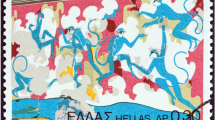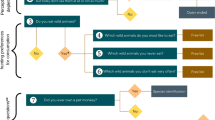Abstract
In their reply to our article “A new identification of the monkeys depicted in a Bronze Age wall painting from Akrotiri, Thera” [Primates 61(3), 2019], Urbani and Youlatos (Primates https://doi.org/10.1007/s10329-020-00825-2, 2020) argue for the traditional identification of the monkeys depicted on the north and west walls of Room 6 of Building Complex Beta at Akrotiri, Thera, as vervet monkeys (Fig. 1). Their argument is based largely on previous scholarship and their analysis of monkey morphology as it appears in this Bronze Age artwork. Here, after clarifying some misconceptions and misquotations, we thoroughly contextualize the wall painting in question, emphasizing the importance of collaboration between disparate disciplines for a multifaceted and rigorous approach. The nature of the item in question is key in this reply: it is an artwork. Because the artwork in question is a cultural representation of monkeys rather than a study of live primates or preserved specimens, consideration of artistic choice, color conventions, and the agency of the artist, which are important facets of material culture, is important when answering the questions raised by Urbani and Youlatos, and should stimulate further cross-disciplinary discussions.



Adapted from Google Earth

Similar content being viewed by others
References
Arnott R (2020) Crossing continents: between India and the Aegean: from prehistory to Alexander the Great. Oxford, Oxbow (in press)
Aruz J (2003) Art of the first cities: the third millennium B.C. from the Mediterranean to the Indus. Yale University Press, New Haven
Aruz J (2008) Marks of distinction. Seals and cultural exchange between the Aegean and the Orient (ca. 2600–1360 B.C.). von Zabern, Mainz am Rhein
Barnett RD (1973) Monkey business. J Anc Near East Soc 5(1):2132
Becker H (2021) Pigments—color terminology. To each his own name. In: Gliozzo E, Pizzo A, La Russa M (eds) Mortars, plasters, and pigments: research questions and answers. J Archaeol Anthropol Sci, Springer (in press)
Cavassa L, Delamare F, Repoux M (2010) La fabrication du bleu égyptien dans les Champs Phlégréens (Campanie, Italie) durant le Ier siècle de notre ère. Aspects de l’arisanat en milieu urbain: Gaule et Occident romain. Rev Archéol Est [Suppl 28] 235–249
Chakrabarti DK (1993) ‘Long-barrel cylinder’ beads and the issue of Pre-Sargonic contact between the Harappan Civilization and Mesopotamia. In: Possehl G (ed) Harappan civilization. Oxford and IBH Publishers, New Delhi, pp 265–270
Chapin A, Pareja MN (2020) Peacock or poppycock? Investigations into exotic animal imagery in Minoan and Cycladic art. In: Davis B, Laffineur R (eds) ΝΕΩΤΕΡΟΣ: studies in Bronze Age Aegean art and archaeology in honor of Professor John G. Younger on the occasion of his retirement. Aegaeum 44
Chapin AP, Pareja MN (2021) Beyond the boundaries: rarity, marginality, and liminality in Minoan and Cycladic animal art. In Laffineur R (ed) ZOIA. (Aegaeum 45), Peeters, Louvain (in press)
Colburn CS (2008) Exotica and the Early Minoan elite: eastern imports in Prepalatial Crete. Am J Archaeol 112:203–224
Collon D (1995) Ancient Near Eastern art. University of California Press, Berkeley
Collon D (2005) First impressions: cylinder seals in the Ancient Near East. British Museum, London
Doumas C (1992) The wall paintings of Thera, Athens. The Thera Foundation-Petros M, Nomikos
Frison G, Brun G (2016) Lapis lazuli, lazurite, ultramarine ‘blue’, and the color term ‘azure’ up to the 13th century. J Int Color Assoc 16:41–55
Gillis C (2004) The use of colour in the Aegean Bronze Age. In: Cleland L, Stears K (eds) Colour in the ancient Mediterranean world, British Annual Reports International Series 1267 (BAR-IS). Archaeopress, Oxford, pp 56–60
Greenlaw C (2011) The representation of monkeys in the art and thought of Mediterranean cultures: a new perspective on ancient primates. British Archaeological Reports, Oxford
Groman-Yaroslavski I, Mayer DEB-Y (2015) Lapidary technology revealed by functional analysis of carnelian beads from the early Neolithic site of Nahal Hemar Cave, southern Levant. J Archaeol Sci 58:77–88
Harper PO, Aruz J, Tallon F (eds) (1992) The royal city of Susa: Ancient Near Eastern treasures in the Louvre. Abrams, New York
Immerwahr SA (2005) Left or right? A study of hands and feet. In: Morgan L (ed) Aegean wall painting: a tribute to Mark Cameron, British School at Athens Studies 13. British School at Athens, London pp 173–183
Jones M, Hunt H, Kneale C, Lightfoot E, Lister D, Liu X, Motuzaite-Matuzeviciute G (2015) Food globalization in prehistory: the agrarian foundations of an interconnected continent. J Br Acad 4:73–87
Kenoyer JM (2008) Indus and Mesopotamian trade networks: new insight from shell and carnelian artifacts. In: Olijdam E, Spoor RH (eds) Intercultural relations between south and south-west Asia. Studies in Commemoration of E. C. L. During-Caspers 1934–1996. Archaeopress, Oxford, pp 19–28
Kenoyer JM (1997) Trade and technology of the Indus Valley: new insights from Harappa, Pakistan. World Archaeol 29:262–280
Kenoyer JM, Price D, Burton JH (2013) A new approach to tracking connections between the Indus Valley and Mesopotamia: initial results of strontium isotope analyses from Harappa and Ur. J Archaeol Sci 40:2286–2297
Klengel H (1984) Near Eastern trade and the emergence of interaction with Crete in the third millennium BC. Stud Micenei Egeo-Anatolici 24:7–19
Lambrou-Phillipson C (1990) Hellenorientalia: the Near Eastern presence in the Bronze Age Aegean, ca. 3000–1100 B.C. Interconnections based on the material record and the written evidence plus orientalia. A catalogue of Egyptian, Mesopotamian, Mittanian, Syro-Palestinian, Cypriot, and Asia Minor objects from the Bronze Age Aegean. SIMA pocket-book 95, Göteborg
Linares V, Adams MJ, Cradic MS, Finkelstein I, Lipschits O, Martin MAS, Neumann R, Stockhammer PW, Gadot Y (2019) First evidence for vanillin in the old world: its use as a mortuary offering in Middle Bronze Canaan. J Archaeol Sci Rep 25:77–84
Marshall M (2019) Ancient monkey painting suggests Bronze Age Greeks travelled widely. New Scientist, London (Accessed 11 December 2019)
Miller NF, Spengler RN, Frachetti M (2016) Millet cultivation across Eurasia: origins, spread, and the influence of seasonal climate. Holocene 26(10):1566–1575
Moorey PRS (1994) Ancient Mesopotamian materials and industries: the archaeological evidence. Clarendon, Oxford
Morgan L (2005) New discoveries and new ideas in Aegean wall painting. In: Morgan L (ed) Aegean wall painting: a tribute to Mark Cameron, British School at Athens Studies 13. British School at Athens, London, pp 21–44
Pareja MN (2021) Early Bronze Age evidence for possible Aegean-Indus trade. In: Recht L, Zeman-Wisniewska K (eds) Animal iconography in the archaeological record: new approaches, new dimensions. Equinox, Sheffield (in press)
Pareja MN (2019) Reconstructing Minoan cult practices through secondary sources. Proceedings of the 12th International Congress of Cretan Studies, Heraklion, 21–25 September 2016, pp 1–8
Pareja MN (2017) Monkey and ape iconography in Aegean art. Astrom, Uppsala, Sweden
Pittman H (1984) Art of the Bronze Age: Southeastern Iran, Western Central Asia, and the Indus Valley. Metropolitan Museum of Art, New York
Platon N (1947) Συμβολή εις την σπουδήν της μινωικής τοιχογραφίας. Ο κροκοσυλλέκτής πιθηκος. Kret Chron 1:505–524
Powell E (2020) A barrel of Bronze Age monkeys. Archaeol Mag (March/April) 2020:12
Radiolab (2012) Why isn’t the sky blue? https://www.wnycstudios.org/podcasts/radiolab/segments/211213-sky-isnt-blue. Posted 21 May 2012. Last accessed 21 May 2020
Ratnagar S (2004) Trading encounters: from the Euphrates to the Indus in the Bronze Age. Oxford University Press, New Delhi
Reinholdt C (2003) The Early Bronze Age jewellery hoard from Kolonna, Aigina. In: Aruz J (ed) Art of the first cities: the third millennium B.C. from the Mediterranean to the Indus. Met Publications, New York, p 260
Şahoğlu V (2005) The Anatolian trade network and the Izmir region during the Early Bronze Age. Oxf J Archaeol 24(4):339–361
Sarianidi VI, Kowalski LH (1971) The lapis lazuli route in the ancient Near East. Archaeology 24:12–15
Shank E (2005) Evidence for Anatolian relations in Crete in Early Minoan I-IIA. In: Laffineur R, Greco E (eds) Emporia: Aegeans in the Central and Eastern Mediterranean. Proceedings of the 10th International Aegean Conference/10e Recontre égéenne interntionale, Italian School of Archaeology in Athens, 14–18 April 2004, Liège, Histoire de l’art et archéologie de la Grèce antique, University of Liège. Aegaeum 22:103–108
Urbani B, Youlatos Y (2020a) Occam’s razor, archaeoprimatology, and the ‘blue’ monkeys from Thera: a reply to Pareja et al. (2020). Primates. https://doi.org/10.1007/s10329-020-00825-2
Urbani B, Youlatos Y (2020b) A new look at the Minoan ‘blue’ monkeys. Antiquity 94(9):1–5
Van Buren ED (1939) The fauna of ancient Mesopotamia as represented in art. Pontificum Institutum Biblicum, Rome
Valamoti SM (2013) Millet, the late comer: on the tracks of Panicum miliaceum in prehistoric Greece. Archaeol Anthropol Sci 8(1):51–63
Whipple T (2019) Curious tail of monkeys who crossed the ancient world. The Times, London (Accessed online 10 December 2019)
Wilkinson TC (2014) Tying the threads of Eurasia: trans-regional routes and material flows in Transcaucasia, Eastern Anatolia and western Central Asia c. 3000–1500BC. Sidestone, Leiden
Wu KJ (2019) Painted Bronze Age monkeys hint at the interconnectedness of the ancient world. Smithsonian, Washington, DC (Accessed online 16 December 2019)
Acknowledgments
The authors would like to extend their gratitude to the Archaeological Institute of America and the Ancient Painting Studies Interest Group for the opportunity to present the preliminary results of this study. M. N. P. C. personally thanks Robert Arnott, Tristan Carter, Anne P. Chapin, Tiffany L. Hunt, Jonathan M. Kenoyer, Leanna Kolonauski, and Doug Morrow for their thoughts on, and enthusiasm for, this project.
Author information
Authors and Affiliations
Corresponding author
Ethics declarations
Conflict of interest
The authors declare that they have no conflicts of interest.
Ethical approval
No studies with human participants or animals were performed by any of the authors in connection with this article.
Additional information
Publisher's Note
Springer Nature remains neutral with regard to jurisdictional claims in published maps and institutional affiliations.
About this article
Cite this article
Pareja, M.N., McKinney, T. & Setchell, J.M. Aegean monkeys and the importance of cross-disciplinary collaboration in archaeoprimatology: a reply to Urbani and Youlatos. Primates 61, 767–774 (2020). https://doi.org/10.1007/s10329-020-00855-w
Received:
Accepted:
Published:
Issue Date:
DOI: https://doi.org/10.1007/s10329-020-00855-w




